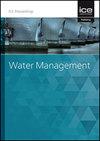Experimental and numerical investigation of rectangular Labyrinth weirs in open channel
IF 0.9
4区 工程技术
Q3 ENGINEERING, CIVIL
Proceedings of the Institution of Civil Engineers-Water Management
Pub Date : 2024-04-25
DOI:10.1680/jwama.22.00112
引用次数: 0
Abstract
Labyrinth weirs are commonly used hydraulic structures to increase discharge efficiency in free-overflow discharges. These weirs provide higher discharge efficiency than conventional linear weirs at the same headwaters. This study investigated hydraulic performance of rectangular labyrinth weirs under different geometries and flow conditions experimentally and numerically. The numerical model was verified and validated using the grid convergence index method recommended in the literature and the experimental data. The numerical modelling results showed that the increase in performance of the labyrinth weir was caused by the distribution of lateral velocities in the inlet keys, while the nappe interference in the downstream keys was responsible for the decrease in performance at high headwater. Within the limitations of 1.5≤L/B≤2.33 and 0.1<Ho/P<0.61, a performance increase of 44% on average and a maximum of 67% for unit channel width was found for rectangular labyrinth weirs compared to linear weirs. For given limitations, two new empirical formulas with high correlation were derived to estimate the discharge coefficients of rectangular labyrinth weirs based on channel width (B) and weir crest length (L) for Ho/P>0.1 in which are widely used in practice. It is concluded that, when compared with some of the data in the literature, the empirical formulas give satisfactory results.明渠矩形迷宫堰的实验和数值研究
迷宫堰是常用的水力结构,可提高自由溢流排水的排放效率。与传统的直线型堰渠相比,迷宫堰渠在相同水头的排泄效率更高。本研究通过实验和数值方法研究了矩形迷宫堰在不同几何形状和流动条件下的水力性能。利用文献中推荐的网格收敛指数法和实验数据对数值模型进行了验证和确认。数值建模结果表明,迷宫堰性能的提高是由入口堰体的横向流速分布造成的,而下游堰体的锥体干扰则是高水头时性能下降的原因。在 1.5≤L/B≤2.33 和 0.1<Ho/P<0.61 的限制条件下,矩形迷宫堰与直线堰相比,单位河道宽度的性能平均提高了 44%,最大提高了 67%。针对上述局限性,得出了两个新的相关性较高的经验公式,用于估算实践中广泛使用的基于渠道宽度(B)和堰顶长度(L)(Ho/P>0.1)的矩形迷宫堰的排泄系数。结论是,与文献中的一些数据相比,经验公式给出了令人满意的结果。
本文章由计算机程序翻译,如有差异,请以英文原文为准。
求助全文
约1分钟内获得全文
求助全文
来源期刊
CiteScore
2.10
自引率
0.00%
发文量
28
审稿时长
6-12 weeks
期刊介绍:
Water Management publishes papers on all aspects of water treatment, water supply, river, wetland and catchment management, inland waterways and urban regeneration.
Topics covered: applied fluid dynamics and water (including supply, treatment and sewerage) and river engineering; together with the increasingly important fields of wetland and catchment management, groundwater and contaminated land, waterfront development and urban regeneration. The scope also covers hydroinformatics tools, risk and uncertainty methods, as well as environmental, social and economic issues relating to sustainable development.

 求助内容:
求助内容: 应助结果提醒方式:
应助结果提醒方式:


